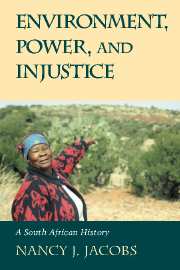Book contents
- Frontmatter
- Contents
- List of Illustrations
- List of Tables
- Preface
- Abbreviations
- 1 Approaching Kuruman
- 2 Goat People and Fish People on the Agro-Pastoral Frontier, c. 1750–1830
- 3 Intensification and Social Innovation on the Cape Frontier, 1820s–1884
- 4 Colonial Annexation: Land Alienation and Environmental Administration, 1884–1894
- 5 Environmental Trauma, Colonial Rule, and the Failure of Extensive Food Production, 1895–1903
- 6 The Environmental History of a “Labor Reservoir,” 1903–1970s
- 7 Apportioning Water, Dividing Land: Segregation, 1910–1977
- 8 Betterment and the Bophuthatswana Donkey Massacre: The Environmental Rights of Tribal Subjects, 1940s–1983
- 9 Retrospectives on Socio-Environmental History and Socio-Environmental Justice
- Appendix A South African Census Statistics on Human Population
- Appendix B South African Census Statistics on Stock Population
- Appendix C1 1991 Individual Interviews
- Appendix C2 1997–1998 Individual Interviews
- Appendix C3 1991 and 1997–1998 Group Interviews
- Appendix D A Note on Archival Sources
- Notes
- Index
2 - Goat People and Fish People on the Agro-Pastoral Frontier, c. 1750–1830
Published online by Cambridge University Press: 05 July 2009
- Frontmatter
- Contents
- List of Illustrations
- List of Tables
- Preface
- Abbreviations
- 1 Approaching Kuruman
- 2 Goat People and Fish People on the Agro-Pastoral Frontier, c. 1750–1830
- 3 Intensification and Social Innovation on the Cape Frontier, 1820s–1884
- 4 Colonial Annexation: Land Alienation and Environmental Administration, 1884–1894
- 5 Environmental Trauma, Colonial Rule, and the Failure of Extensive Food Production, 1895–1903
- 6 The Environmental History of a “Labor Reservoir,” 1903–1970s
- 7 Apportioning Water, Dividing Land: Segregation, 1910–1977
- 8 Betterment and the Bophuthatswana Donkey Massacre: The Environmental Rights of Tribal Subjects, 1940s–1983
- 9 Retrospectives on Socio-Environmental History and Socio-Environmental Justice
- Appendix A South African Census Statistics on Human Population
- Appendix B South African Census Statistics on Stock Population
- Appendix C1 1991 Individual Interviews
- Appendix C2 1997–1998 Individual Interviews
- Appendix C3 1991 and 1997–1998 Group Interviews
- Appendix D A Note on Archival Sources
- Notes
- Index
Summary
A Matchappee, being told that cows, oxen, sheep, and other animals were made for certain purposes, such as to feed and clothe men, was asked for what purpose he thought man was made. He answered, to go on plundering expeditions against other people.
When groups meet in frontier zones, they have to negotiate many issues, including the ways of using the environment. Because these encounters introduce and establish new environmental relations, they are of particular interest to environmental historians. In early Kuruman, as in other places, frontier encounters provided fuel for a dynamic of change. In fact, the two major considerations of this book – social difference in environmental relations and the process of intensification – first appeared with the agro-pastoral frontier washing over Kuruman in the eighteenth century. Thus, our starting point for the environmental history is the shift from foraging to herding and growing crops and the associated political and social changes on the agro-pastoral frontier.
Broadly speaking, southern African frontiers involved contact between three economic groups that largely correspond to linguistic groups. The first inhabitants were foraging “bushmen,” or “San,” who spoke the click languages of the Khoisan family. Second were the Khoikhoi, also speaking a Khoisan language, who kept stock, although they did not cultivate. Third and last appearing were the agro-pastoralists, whose men herded cattle, sheep, and goats, while the women cultivated with iron tools.
- Type
- Chapter
- Information
- Environment, Power, and InjusticeA South African History, pp. 32 - 56Publisher: Cambridge University PressPrint publication year: 2003

